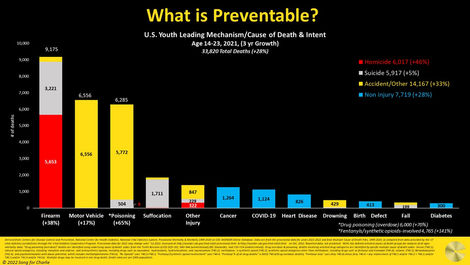
SPOTLIGHT STATS
For the 12 months ending December 2021, CDC projects for all ages:
-
107K-109K total drug-induced deaths, +16% vs. prior year.
-
Over 72K (66%) of these deaths involved fentanyl & other synthetic opioids, mostly illicit, and often in combination with other drugs; this is +26% vs. prior year.
Youth (Age 14-23) drug-induced deaths:
-
In 2021, 6,000 youth will have died from drugs with fentanyl involved, 4,800 of them with fentanyl involved, 79% of all youth drug death
-
Drug deaths are second behind car accidents in accidental deaths, about equal to homicide & suicides in leading overall deaths
-
Youth drug deaths have quadrupled over 20 years, driven recently by Fentanyl involvement which has grown over 6X since 2015 (+558%)
-
Meanwhile, in the same 5 years, deaths involving Meth, Cocaine, Heroin, Benzos, & Legit Opioids combined have been mostly flat (+16%)
-
Fentanyl is involved in more youth death than all other drug types combined; many deaths involve multiple drugs
-
Since 2018, Teen (14-18) drug deaths have grown faster than any other age group (+152%) driven by fentanyl (+356%); this is about 3x faster than the U.S. all ages growth rates
-
Counterfeit pill seizures have grown 50-fold since beginning of 2018 to end of 2021, over 10M pills per year
“Warn the Kids” Research:
-
4 out of 5 young Americans say people their age feel overwhelmed
-
Common stressors for young Americans include academics, social concerns, finances, and their future. Coping with stress & anxiety is a leading reason for young Americans to misuse prescription medication
-
16% of young Americans have misused prescription medicine, 22% have thought about it, and 20% say they are likely to or are unsure about misusing prescription medication in the future
-
89% of young Americans feel that misusing prescription medicine is ‘risky’, but only 68% consider taking Rx opioids off script as ‘dangerous’ (even less for benzos (eg Xanax) and stimulants (eg Adderall))
-
Less than half (48%) of young Americans – including just more than a third (36%) of teens – are aware that fentanyl is being used to create counterfeit pills
-
Only 2 in 5 young Americans consider themselves knowledgeable about fentanyl. 68% consider fentanyl to be dangerous, far less than heroin (84%) and cocaine (81%) even though fentanyl is involved in 17x more deaths than heroin and 5x more than cocaine. Nearly 20% of young Americans don’t know enough about fentanyl to rate its danger
-
After reviewing targeted information about fentanyl in fake pills, 65% of young Americans are less likely to consider misusing Rx drugs
-
Those who know the dangers of fentanyl are significantly less likely to consider misusing Rx drugs in the future


CURRENT
DATA
Updated October 2022. All mortality data derived from CDC; final through December 2020 + provisional through December 2021
Browse through some of our helpful resources to learn more about fentapills and fentanyl.





























